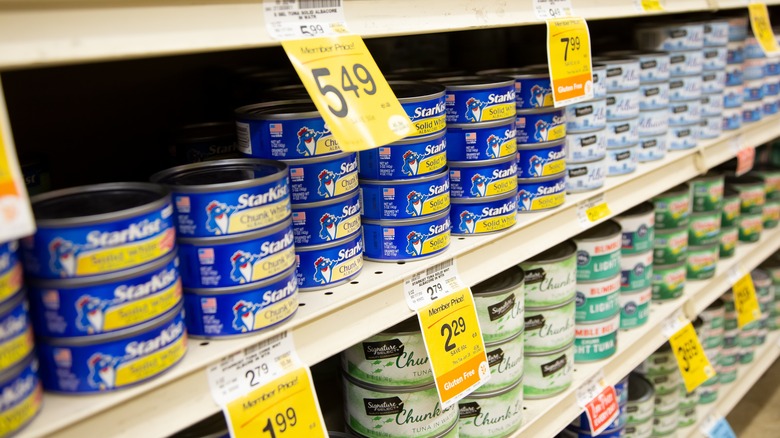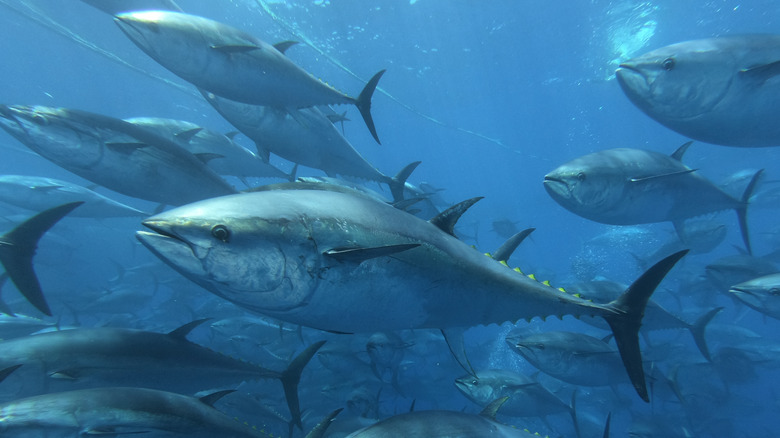The Risk You Can Easily Avoid By Reading Canned Tuna Labels
Canned tuna is the perfect cheap, convenient, and tasty pantry staple, perfect for recipes like a classic grilled tuna salad sandwich or upscale tuna casserole — or for those of us who love to eat it straight out of the can. According to Healthline, tuna is also high in protein, low in fat and calories, and contains DHA, an omega-3 fatty acid that's important for brain and eye health. But one of the main drawbacks of the "chicken of the sea" is that all tuna contains at least trace amounts of mercury, and certain kinds of canned tuna have more than others.
Out of the two most popular types of canned tuna — chunk light tuna and chunk white tuna — chunk white tuna has the highest levels of mercury. Mercury levels in chunk white tuna, such as albacore, can be up to three times higher than those found in "light" canned tuna products. When buying the canned fish at the grocery store, paying attention to labels is a must in order to avoid consuming higher levels of mercury.
Does all tuna have mercury?
The presence of mercury isn't unique to tuna, as pretty much all fish are contaminated in some way. The water that makes up their environment is often contaminated with heavy metals, so the fish are subsequently also impacted. What is unique to tuna in comparison to other species of fish is that tuna eat other, smaller fish. The levels of mercury in these other fish are absorbed into the tuna over time, making tuna's levels of mercury higher than in other types of large seafood.
Bigger tuna species, like albacore or bigeye, contain more of the heavy metal, and chunk white canned tuna is mostly of the albacore variety. Smaller varieties of tuna like skipjack generally have lower mercury levels, which is why you can avoid the risk of ingesting too much mercury by buying light canned tuna instead of albacore. Interestingly, it also seems that mercury levels vary even within brands. According to a study done by Consumer Reports, the brand Chicken of the Sea's albacore canned tuna had ten times more mercury than its light tuna. In comparison, Wild Planet's albacore and skipjack tuna varieties actually had similar levels of mercury.
Mercury has some significant health impacts
Ingesting too much mercury is a serious risk, especially for young children and pregnant people. For adults with no health conditions, eating high-mercury fish like tuna at least once a week can cause symptoms like fatigue. Mercury poisoning in adults can lead to fertility issues, problems regulating blood pressure, and can even cause memory loss. In children, the heavy metal poses an even larger risk and can cause learning disabilities and developmental delays.
So how much tuna is too much? According to the Food and Drug Administration, two to three servings of tuna per week is safe, even for those who might become pregnant or are breastfeeding, as well as for children up to eleven years old. But Consumer Reports' study says that, for albacore products from certain tuna brands, adults should only eat five ounces of albacore per week to be safe. The study also found that individual cans of tuna can be outliers and have significantly more mercury in them than usual. One in five cans they studied had this spike in mercury content, so predicting the amount you're ingesting is never an exact science, and Consumer Reports recommends that pregnant people avoid canned tuna altogether. Ultimately, your best bet at minimizing the risks that can come with tuna is buying the right kind and limiting your consumption.



